 , (*1)
, (*1)
Laravel Roles
A Powerful package for handling roles and permissions in Laravel. Supports Laravel 5.3, 5.4, 5.5, 5.6, 5.7, 5.8, 6.0, 7.0, and 8.0+., (*2)








 , (*3)
, (*3)
Table of contents
Features
| Laravel Roles Features |
| Built in migrations with ability to publish and modify your own. |
| Built in seed with ability to publish and modify your own. |
| Roles with levels and relationships to users, permissions |
| Permissions with relationships to users and levels |
| Soft deletes with full restore and destroy |
| Optional CRUD of Roles and Permissions |
| Lots of configuration options |
| All Extendable from .env
|
Installation
This package is very easy to set up. There are only couple of steps., (*4)
Composer
From your projects root folder in terminal run:, (*5)
Laravel 5.8 and up use:, (*6)
composer require jeremykenedy/laravel-roles
Laravel 5.7 and below use:, (*7)
composer require jeremykenedy/laravel-roles:1.4.0
- Note: The major difference is that Laravel's users table migration out the box changed from
$table->increments('id'); to $table->bigIncrements('id'); in Laravel 5.8.
Service Provider
-
Laravel 5.5 and up
Uses package auto discovery feature, no need to edit the config/app.php file., (*8)
-
Laravel 5.4 and below
Add the package to your application service providers in config/app.php file., (*9)
'providers' => [
...
/**
* Third Party Service Providers...
*/
jeremykenedy\LaravelRoles\RolesServiceProvider::class,
],
Publish All Assets
php artisan vendor:publish --tag=laravelroles
Publish Specific Assets
php artisan vendor:publish --tag=laravelroles-config
php artisan vendor:publish --tag=laravelroles-migrations
php artisan vendor:publish --tag=laravelroles-seeds
php artisan vendor:publish --tag=laravelroles-views
php artisan vendor:publish --tag=laravelroles-lang
HasRoleAndPermission Trait And Contract
-
Include HasRoleAndPermission trait and also implement HasRoleAndPermission contract inside your User model. See example below., (*10)
-
Include use jeremykenedy\LaravelRoles\Traits\HasRoleAndPermission; in the top of your User model below the namespace and implement the HasRoleAndPermission trait. See example below., (*11)
Example User model Trait And Contract:, (*12)
<?php
namespace App;
use Illuminate\Database\Eloquent\Model;
use Illuminate\Notifications\Notifiable;
use jeremykenedy\LaravelRoles\Traits\HasRoleAndPermission;
use Illuminate\Foundation\Auth\User as Authenticatable;
class User extends Authenticatable
{
use Notifiable;
use HasRoleAndPermission;
// rest of your model ...
}
Migrations and seeds
This uses the default users table which is in Laravel. You should already have the migration file for the users table available and migrated., (*13)
-
Setup the needed tables:, (*14)
php artisan migrate, (*15)
-
Update database\seeds\DatabaseSeeder.php to include the seeds. See example below., (*16)
<?php
use Illuminate\Database\Seeder;
use Illuminate\Database\Eloquent\Model;
use Database\Seeders\PermissionsTableSeeder;
use Database\Seeders\RolesTableSeeder;
use Database\Seeders\ConnectRelationshipsSeeder;
class DatabaseSeeder extends Seeder
{
/**
* Run the database seeds.
*
* @return void
*/
public function run()
{
Model::unguard();
$this->call(PermissionsTableSeeder::class);
$this->call(RolesTableSeeder::class);
$this->call(ConnectRelationshipsSeeder::class);
//$this->call('UsersTableSeeder');
Model::reguard();
}
}
- Seed an initial set of Permissions, Roles, and Users with roles.
composer dump-autoload
php artisan db:seed
Roles Seeded
| Property |
Value |
| Name |
Admin |
| Slug |
admin |
| Description |
Admin Role |
| Level |
5 |
| Property |
Value |
| Name |
User |
| Slug |
user |
| Description |
User Role |
| Level |
1 |
| Property |
Value |
| Name |
Unverified |
| Slug |
unverified |
| Description |
Unverified Role |
| Level |
0 |
Permissions Seeded:
| Property |
Value |
| name |
Can View Users |
| slug |
view.users |
| description |
Can view users |
| model |
Permission |
| Property |
Value |
| name |
Can Create Users |
| slug |
create.users |
| description |
Can create new users |
| model |
Permission |
| Property |
Value |
| name |
Can Edit Users |
| slug |
edit.users |
| description |
Can edit users |
| model |
Permission |
| Property |
Value |
| name |
Can Delete Users |
| slug |
delete.users |
| description |
Can delete users |
| model |
Permission |
And that's it!
Migrate from bican roles
If you migrate from bican/roles to jeremykenedy/LaravelRoles you will need to update a few things.
- Change all calls to can, canOne and canAll to hasPermission, hasOnePermission, hasAllPermissions.
- Change all calls to is, isOne and isAll to hasRole, hasOneRole, hasAllRoles., (*17)
Usage
Creating Roles
$adminRole = config('roles.models.role')::create([
'name' => 'Admin',
'slug' => 'admin',
'description' => '',
'level' => 5,
]);
$moderatorRole = config('roles.models.role')::create([
'name' => 'Forum Moderator',
'slug' => 'forum.moderator',
]);
Because of Slugable trait, if you make a mistake and for example leave a space in slug parameter, it'll be replaced with a dot automatically, because of str_slug function., (*18)
Attaching, Detaching and Syncing Roles
It's really simple. You fetch a user from database and call attachRole method. There is BelongsToMany relationship between User and Role model., (*19)
$user = config('roles.models.defaultUser')::find($id);
$user->attachRole($adminRole); // you can pass whole object, or just an id
$user->detachRole($adminRole); // in case you want to detach role
$user->detachAllRoles(); // in case you want to detach all roles
$user->syncRoles($roles); // you can pass Eloquent collection, or just an array of ids
Assign a user role to new registered users
You can assign the user a role upon the users registration by updating the file app\Http\Controllers\Auth\RegisterController.php.
You can assign a role to a user upon registration by including the needed models and modifying the create() method to attach a user role. See example below:, (*20)
- Updated
create() method of app\Http\Controllers\Auth\RegisterController.php:
protected function create(array $data)
{
$user = config('roles.models.defaultUser')::create([
'name' => $data['name'],
'email' => $data['email'],
'password' => bcrypt($data['password']),
]);
$role = config('roles.models.role')::where('name', '=', 'User')->first(); //choose the default role upon user creation.
$user->attachRole($role);
return $user;
}
Checking For Roles
You can now check if the user has required role., (*21)
if ($user->hasRole('admin')) { // you can pass an id or slug
//
}
You can also do this:, (*22)
if ($user->isAdmin()) {
//
}
And of course, there is a way to check for multiple roles:, (*23)
if ($user->hasRole(['admin', 'moderator'])) {
/*
| Or alternatively:
| $user->hasRole('admin, moderator'), $user->hasRole('admin|moderator'),
| $user->hasOneRole('admin, moderator'), $user->hasOneRole(['admin', 'moderator']), $user->hasOneRole('admin|moderator')
*/
// The user has at least one of the roles
}
if ($user->hasRole(['admin', 'moderator'], true)) {
/*
| Or alternatively:
| $user->hasRole('admin, moderator', true), $user->hasRole('admin|moderator', true),
| $user->hasAllRoles('admin, moderator'), $user->hasAllRoles(['admin', 'moderator']), $user->hasAllRoles('admin|moderator')
*/
// The user has all roles
}
Levels
When you are creating roles, there is optional parameter level. It is set to 1 by default, but you can overwrite it and then you can do something like this:, (*24)
if ($user->level() > 4) {
//
}
If user has multiple roles, method level returns the highest one., (*25)
Level has also big effect on inheriting permissions. About it later., (*26)
Creating Permissions
It's very simple thanks to Permission model called from config('roles.models.permission')., (*27)
$createUsersPermission = config('roles.models.permission')::create([
'name' => 'Create users',
'slug' => 'create.users',
'description' => '', // optional
]);
$deleteUsersPermission = config('roles.models.permission')::create([
'name' => 'Delete users',
'slug' => 'delete.users',
]);
Attaching, Detaching and Syncing Permissions
You can attach permissions to a role or directly to a specific user (and of course detach them as well)., (*28)
$role = config('roles.models.role')::find($roleId);
$role->attachPermission($createUsersPermission); // permission attached to a role
$user = config('roles.models.defaultUser')::find($userId);
$user->attachPermission($deleteUsersPermission); // permission attached to a user
$role->detachPermission($createUsersPermission); // in case you want to detach permission
$role->detachAllPermissions(); // in case you want to detach all permissions
$role->syncPermissions($permissions); // you can pass Eloquent collection, or just an array of ids
$user->detachPermission($deleteUsersPermission);
$user->detachAllPermissions();
$user->syncPermissions($permissions); // you can pass Eloquent collection, or just an array of ids
Checking For Permissions
if ($user->hasPermission('create.users')) { // you can pass an id or slug
//
}
if ($user->canDeleteUsers()) {
//
}
You can check for multiple permissions the same way as roles. You can make use of additional methods like hasOnePermission or hasAllPermissions., (*29)
Permissions Inheritance
By default, roles with higher level inherit all permissions from roles with lower level., (*30)
For example:, (*31)
You have three roles: user, moderator and admin. User has a permission to read articles, moderator can manage comments and admin can create articles. User has a level 1, moderator level 2 and admin level 3. With inheritance enabled, moderator and administrator also have the permission to read articles, and administrator can manage comments as well., (*32)
If you don't want the permissions inheritance feature enabled in you application, set the config value roles.inheritance (or its corresponding .env parameter, ROLES_INHERITANCE) to false. Alternatively, simply ignore the level parameter when you're creating roles., (*33)
Entity Check
Let's say you have an article and you want to edit it. This article belongs to a user (there is a column user_id in articles table)., (*34)
use App\Article;
$editArticlesPermission = config('roles.models.permission')::create([
'name' => 'Edit articles',
'slug' => 'edit.articles',
'model' => 'App\Article',
]);
$user->attachPermission($editArticlesPermission);
$article = Article::find(1);
if ($user->allowed('edit.articles', $article)) { // $user->allowedEditArticles($article)
//
}
This condition checks if the current user is the owner of article. If not, it will be looking inside user permissions for a row we created before., (*35)
if ($user->allowed('edit.articles', $article, false)) { // now owner check is disabled
//
}
Blade Extensions
There are four Blade extensions. Basically, it is replacement for classic if statements., (*36)
@role('admin') // @if(Auth::check() && Auth::user()->hasRole('admin'))
// user has admin role
@endrole
@permission('edit.articles') // @if(Auth::check() && Auth::user()->hasPermission('edit.articles'))
// user has edit articles permissison
@endpermission
@level(2) // @if(Auth::check() && Auth::user()->level() >= 2)
// user has level 2 or higher
@endlevel
@allowed('edit', $article) // @if(Auth::check() && Auth::user()->allowed('edit', $article))
// show edit button
@endallowed
@role('admin|moderator', true) // @if(Auth::check() && Auth::user()->hasRole('admin|moderator', true))
// user has admin and moderator role
@else
// something else
@endrole
Middleware
This package comes with VerifyRole, VerifyPermission and VerifyLevel middleware.
The middleware aliases are already registered in \jeremykenedy\LaravelRoles\RolesServiceProvider as of 1.7.
You can optionally add them inside your app/Http/Kernel.php file with your own aliases like outlined below:, (*37)
/**
* The application's route middleware.
*
* @var array
*/
protected $routeMiddleware = [
'auth' => \App\Http\Middleware\Authenticate::class,
'auth.basic' => \Illuminate\Auth\Middleware\AuthenticateWithBasicAuth::class,
'bindings' => \Illuminate\Routing\Middleware\SubstituteBindings::class,
'cache.headers' => \Illuminate\Http\Middleware\SetCacheHeaders::class,
'can' => \Illuminate\Auth\Middleware\Authorize::class,
'guest' => \App\Http\Middleware\RedirectIfAuthenticated::class,
'signed' => \Illuminate\Routing\Middleware\ValidateSignature::class,
'throttle' => \Illuminate\Routing\Middleware\ThrottleRequests::class,
'verified' => \Illuminate\Auth\Middleware\EnsureEmailIsVerified::class,
'role' => \jeremykenedy\LaravelRoles\App\Http\Middleware\VerifyRole::class,
'permission' => \jeremykenedy\LaravelRoles\App\Http\Middleware\VerifyPermission::class,
'level' => \jeremykenedy\LaravelRoles\App\Http\Middleware\VerifyLevel::class,
];
Now you can easily protect your routes., (*38)
Route::get('/', function () {
//
})->middleware('role:admin');
Route::get('/', function () {
//
})->middleware('permission:edit.articles');
Route::get('/', function () {
//
})->middleware('level:2'); // level >= 2
Route::get('/', function () {
//
})->middleware('role:admin', 'level:2'); // level >= 2 and Admin
Route::group(['middleware' => ['role:admin']], function () {
//
});
It throws \jeremykenedy\LaravelRoles\App\Exceptions\RoleDeniedException, \jeremykenedy\LaravelRoles\App\Exceptions\PermissionDeniedException or \jeremykenedy\LaravelRoles\App\Exceptions\LevelDeniedException exceptions if it goes wrong., (*39)
You can catch these exceptions inside app/Exceptions/Handler.php file and do whatever you want., (*40)
/**
* Render an exception into an HTTP response.
*
* @param \Illuminate\Http\Request $request
* @param \Throwable $e
* @return \Illuminate\Http\Response
*/
public function render($request, Throwable $e)
{
$userLevelCheck = $e instanceof \jeremykenedy\LaravelRoles\App\Exceptions\RoleDeniedException ||
$e instanceof \jeremykenedy\LaravelRoles\App\Exceptions\PermissionDeniedException ||
$e instanceof \jeremykenedy\LaravelRoles\App\Exceptions\LevelDeniedException;
if ($userLevelCheck) {
if ($request->expectsJson()) {
return Response::json(array(
'error' => 403,
'message' => 'Unauthorized.'
), 403);
}
abort(403);
}
return parent::render($request, $e);
}
Configuration
- You can change connection for models, slug separator, models path and there is also a handy pretend feature.
- There are many configurable options which have been extended to be able to configured via
.env file variables.
- Editing the configuration file directly may not needed becuase of this.
- See config file: roles.php.
<?php
return [
/*
|--------------------------------------------------------------------------
| Package Connection
|--------------------------------------------------------------------------
|
| You can set a different database connection for this package. It will set
| new connection for models Role and Permission. When this option is null,
| it will connect to the main database, which is set up in database.php
|
*/
'connection' => env('ROLES_DATABASE_CONNECTION', null),
'rolesTable' => env('ROLES_ROLES_DATABASE_TABLE', 'roles'),
'roleUserTable' => env('ROLES_ROLE_USER_DATABASE_TABLE', 'role_user'),
'permissionsTable' => env('ROLES_PERMISSIONS_DATABASE_TABLE', 'permissions'),
'permissionsRoleTable' => env('ROLES_PERMISSION_ROLE_DATABASE_TABLE', 'permission_role'),
'permissionsUserTable' => env('ROLES_PERMISSION_USER_DATABASE_TABLE', 'permission_user'),
/*
|--------------------------------------------------------------------------
| Slug Separator
|--------------------------------------------------------------------------
|
| Here you can change the slug separator. This is very important in matter
| of magic method __call() and also a `Slugable` trait. The default value
| is a dot.
|
*/
'separator' => env('ROLES_DEFAULT_SEPARATOR', '.'),
/*
|--------------------------------------------------------------------------
| Models
|--------------------------------------------------------------------------
|
| If you want, you can replace default models from this package by models
| you created. Have a look at `jeremykenedy\LaravelRoles\Models\Role` model and
| `jeremykenedy\LaravelRoles\Models\Permission` model.
|
*/
'models' => [
'role' => env('ROLES_DEFAULT_ROLE_MODEL', jeremykenedy\LaravelRoles\Models\Role::class),
'permission' => env('ROLES_DEFAULT_PERMISSION_MODEL', jeremykenedy\LaravelRoles\Models\Permission::class),
'defaultUser' => env('ROLES_DEFAULT_USER_MODEL', config('auth.providers.users.model')),
],
/*
|--------------------------------------------------------------------------
| Roles, Permissions and Allowed "Pretend"
|--------------------------------------------------------------------------
|
| You can pretend or simulate package behavior no matter what is in your
| database. It is really useful when you are testing you application.
| Set up what will methods hasRole(), hasPermission() and allowed() return.
|
*/
'pretend' => [
'enabled' => false,
'options' => [
'hasRole' => true,
'hasPermission' => true,
'allowed' => true,
],
],
/*
|--------------------------------------------------------------------------
| Default Migrations
|--------------------------------------------------------------------------
|
| These are the default package migrations. If you publish the migrations
| to your project, then this is not necessary and should be disabled. This
| will enable our default migrations.
|
*/
'defaultMigrations' => [
'enabled' => env('ROLES_MIGRATION_DEFAULT_ENABLED', false),
],
/*
|--------------------------------------------------------------------------
| Default Seeds
|--------------------------------------------------------------------------
|
| These are the default package seeds. You can seed the package built
| in seeds without having to seed them. These seed directly from
| the package. These are not the published seeds.
|
*/
'defaultSeeds' => [
'PermissionsTableSeeder' => env('ROLES_SEED_DEFAULT_PERMISSIONS', true),
'RolesTableSeeder' => env('ROLES_SEED_DEFAULT_ROLES', true),
'ConnectRelationshipsSeeder' => env('ROLES_SEED_DEFAULT_RELATIONSHIPS', true),
'UsersTableSeeder' => env('ROLES_SEED_DEFAULT_USERS', false),
],
/*
|--------------------------------------------------------------------------
| Laravel Roles GUI Settings
|--------------------------------------------------------------------------
|
| This is the GUI for Laravel Roles to be able to CRUD them
| easily and fast. This is optional and is not needed
| for your application.
|
*/
// Enable Optional Roles Gui
'rolesGuiEnabled' => env('ROLES_GUI_ENABLED', false),
// Enable `auth` middleware
'rolesGuiAuthEnabled' => env('ROLES_GUI_AUTH_ENABLED', true),
// Enable Roles GUI middleware
'rolesGuiMiddlewareEnabled' => env('ROLES_GUI_MIDDLEWARE_ENABLED', true),
// Optional Roles GUI Middleware
'rolesGuiMiddleware' => env('ROLES_GUI_MIDDLEWARE', 'role:admin'),
// User Permissions or Role needed to create a new role
'rolesGuiCreateNewRolesMiddlewareType' => env('ROLES_GUI_CREATE_ROLE_MIDDLEWARE_TYPE', 'role'), //permissions or roles
'rolesGuiCreateNewRolesMiddleware' => env('ROLES_GUI_CREATE_ROLE_MIDDLEWARE_TYPE', 'admin'), // admin, XXX. ... or perms.XXX
// User Permissions or Role needed to create a new permission
'rolesGuiCreateNewPermissionMiddlewareType' => env('ROLES_GUI_CREATE_PERMISSION_MIDDLEWARE_TYPE', 'role'), //permissions or roles
'rolesGuiCreateNewPermissionsMiddleware' => env('ROLES_GUI_CREATE_PERMISSION_MIDDLEWARE_TYPE', 'admin'), // admin, XXX. ... or perms.XXX
// The parent blade file
'bladeExtended' => env('ROLES_GUI_BLADE_EXTENDED', 'layouts.app'),
// Blade Extension Placement
'bladePlacement' => env('ROLES_GUI_BLADE_PLACEMENT', 'yield'),
'bladePlacementCss' => env('ROLES_GUI_BLADE_PLACEMENT_CSS', 'inline_template_linked_css'),
'bladePlacementJs' => env('ROLES_GUI_BLADE_PLACEMENT_JS', 'inline_footer_scripts'),
// Titles placement extend
'titleExtended' => env('ROLES_GUI_TITLE_EXTENDED', 'template_title'),
// Switch Between bootstrap 3 `panel` and bootstrap 4 `card` classes
'bootstapVersion' => env('ROLES_GUI_BOOTSTRAP_VERSION', '4'),
// Additional Card classes for styling -
// See: https://getbootstrap.com/docs/4.0/components/card/#background-and-color
// Example classes: 'text-white bg-primary mb-3'
'bootstrapCardClasses' => env('ROLES_GUI_CARD_CLASSES', ''),
// Bootstrap Tooltips
'tooltipsEnabled' => env('ROLES_GUI_TOOLTIPS_ENABLED', true),
// jQuery
'enablejQueryCDN' => env('ROLES_GUI_JQUERY_CDN_ENABLED', true),
'JQueryCDN' => env('ROLES_GUI_JQUERY_CDN_URL', 'https://code.jquery.com/jquery-3.3.1.min.js'),
// Selectize JS
'enableSelectizeJsCDN' => env('ROLES_GUI_SELECTIZEJS_CDN_ENABLED', true),
'SelectizeJsCDN' => env('ROLES_GUI_SELECTIZEJS_CDN_URL', 'https://cdnjs.cloudflare.com/ajax/libs/selectize.js/0.12.6/js/standalone/selectize.min.js'),
'enableSelectizeJs' => env('ROLES_GUI_SELECTIZEJS_ENABLED', true),
'enableSelectizeJsCssCDN' => env('ROLES_GUI_SELECTIZEJS_CSS_CDN_ENABLED', true),
'SelectizeJsCssCDN' => env('ROLES_GUI_SELECTIZEJS_CSS_CDN_URL', 'https://cdnjs.cloudflare.com/ajax/libs/selectize.js/0.12.6/css/selectize.min.css'),
// Font Awesome
'enableFontAwesomeCDN' => env('ROLES_GUI_FONT_AWESOME_CDN_ENABLED', true),
'fontAwesomeCDN' => env('ROLES_GUI_FONT_AWESOME_CDN_URL', 'https://maxcdn.bootstrapcdn.com/font-awesome/4.7.0/css/font-awesome.min.css'),
// Flash Messaging
'builtInFlashMessagesEnabled' => env('ROLES_GUI_FLASH_MESSAGES_ENABLED', true),
/*
|--------------------------------------------------------------------------
| Laravel Roles API Settings
|--------------------------------------------------------------------------
|
| This is the API for Laravel Roles to be able to CRUD them
| easily and fast via an API. This is optional and is
| not needed for your application.
|
*/
'rolesApiEnabled' => env('ROLES_API_ENABLED', false),
// Enable `auth` middleware
'rolesAPIAuthEnabled' => env('ROLES_API_AUTH_ENABLED', true),
// Enable Roles API middleware
'rolesAPIMiddlewareEnabled' => env('ROLES_API_MIDDLEWARE_ENABLED', true),
// Optional Roles API Middleware
'rolesAPIMiddleware' => env('ROLES_API_MIDDLEWARE', 'role:admin'),
// User Permissions or Role needed to create a new role
'rolesAPICreateNewRolesMiddlewareType' => env('ROLES_API_CREATE_ROLE_MIDDLEWARE_TYPE', 'role'), //permissions or roles
'rolesAPICreateNewRolesMiddleware' => env('ROLES_API_CREATE_ROLE_MIDDLEWARE_TYPE', 'admin'), // admin, XXX. ... or perms.XXX
// User Permissions or Role needed to create a new permission
'rolesAPICreateNewPermissionMiddlewareType' => env('ROLES_API_CREATE_PERMISSION_MIDDLEWARE_TYPE', 'role'), //permissions or roles
'rolesAPICreateNewPermissionsMiddleware' => env('ROLES_API_CREATE_PERMISSION_MIDDLEWARE_TYPE', 'admin'), // admin, XXX. ... or perms.XXX
/*
|--------------------------------------------------------------------------
| Laravel Roles GUI Datatables Settings
|--------------------------------------------------------------------------
*/
'enabledDatatablesJs' => env('ROLES_GUI_DATATABLES_JS_ENABLED', false),
'datatablesJsStartCount' => env('ROLES_GUI_DATATABLES_JS_START_COUNT', 25),
'datatablesCssCDN' => env('ROLES_GUI_DATATABLES_CSS_CDN', 'https://cdn.datatables.net/1.10.19/css/dataTables.bootstrap4.min.css'),
'datatablesJsCDN' => env('ROLES_GUI_DATATABLES_JS_CDN', 'https://cdn.datatables.net/1.10.19/js/jquery.dataTables.min.js'),
'datatablesJsPresetCDN' => env('ROLES_GUI_DATATABLES_JS_PRESET_CDN', 'https://cdn.datatables.net/1.10.19/js/dataTables.bootstrap4.min.js'),
/*
|--------------------------------------------------------------------------
| Laravel Roles Package Integration Settings
|--------------------------------------------------------------------------
*/
'laravelUsersEnabled' => env('ROLES_GUI_LARAVEL_ROLES_ENABLED', false),
];
Environment File
# Roles Default Models
ROLES_DEFAULT_USER_MODEL=App\User
ROLES_DEFAULT_ROLE_MODEL=jeremykenedy\LaravelRoles\Models\Role
ROLES_DEFAULT_PERMISSION_MODEL=jeremykenedy\LaravelRoles\Models\Permission
# Roles database information
ROLES_DATABASE_CONNECTION=null
ROLES_ROLES_DATABASE_TABLE=roles
ROLES_ROLE_USER_DATABASE_TABLE=role_user
ROLES_PERMISSIONS_DATABASE_TABLE=permissions
ROLES_PERMISSION_ROLE_DATABASE_TABLE=permission_role
ROLES_PERMISSION_USER_DATABASE_TABLE=permission_user
# Roles Misc Settings
ROLES_DEFAULT_SEPARATOR='.'
# Roles Database Migrations Settings
ROLES_MIGRATION_DEFAULT_ENABLED=true
# Roles Database Seeder Settings
ROLES_SEED_DEFAULT_PERMISSIONS=true
ROLES_SEED_DEFAULT_ROLES=true
ROLES_SEED_DEFAULT_RELATIONSHIPS=true
ROLES_SEED_DEFAULT_USERS=false
# Roles GUI Settings
ROLES_GUI_ENABLED=false
ROLES_GUI_AUTH_ENABLED=true
ROLES_GUI_MIDDLEWARE_ENABLED=true
ROLES_GUI_MIDDLEWARE='role:admin'
ROLES_GUI_CREATE_ROLE_MIDDLEWARE_TYPE='role'
ROLES_GUI_CREATE_ROLE_MIDDLEWARE_TYPE='admin'
ROLES_GUI_CREATE_PERMISSION_MIDDLEWARE_TYPE='role'
ROLES_GUI_CREATE_PERMISSION_MIDDLEWARE_TYPE='admin'
ROLES_GUI_BLADE_EXTENDED='layouts.app'
ROLES_GUI_TITLE_EXTENDED='template_title'
ROLES_GUI_LARAVEL_ROLES_ENABLED=false
ROLES_GUI_TOOLTIPS_ENABLED=true
ROLES_GUI_DATATABLES_JS_ENABLED=false
For more information, please have a look at HasRoleAndPermission contract., (*41)
Optional GUI Routes
+--------+-----------+---------------------------------+-----------------------------------------------+-----------------------------------------------------------------------------------------------------------------+---------------------+
| Domain | Method | URI | Name | Action | Middleware |
+--------+-----------+---------------------------------+-----------------------------------------------+-----------------------------------------------------------------------------------------------------------------+---------------------+
| | GET|HEAD | permission-deleted/{id} | laravelroles::permission-show-deleted | jeremykenedy\LaravelRoles\App\Http\Controllers\LaravelpermissionsDeletedController@show | web,auth,role:admin |
| | DELETE | permission-destroy/{id} | laravelroles::permission-item-destroy | jeremykenedy\LaravelRoles\App\Http\Controllers\LaravelpermissionsDeletedController@destroy | web,auth,role:admin |
| | PUT | permission-restore/{id} | laravelroles::permission-restore | jeremykenedy\LaravelRoles\App\Http\Controllers\LaravelpermissionsDeletedController@restorePermission | web,auth,role:admin |
| | POST | permissions | laravelroles::permissions.store | jeremykenedy\LaravelRoles\App\Http\Controllers\LaravelPermissionsController@store | web,auth,role:admin |
| | GET|HEAD | permissions | laravelroles::permissions.index | jeremykenedy\LaravelRoles\App\Http\Controllers\LaravelPermissionsController@index | web,auth,role:admin |
| | GET|HEAD | permissions-deleted | laravelroles::permissions-deleted | jeremykenedy\LaravelRoles\App\Http\Controllers\LaravelpermissionsDeletedController@index | web,auth,role:admin |
| | DELETE | permissions-deleted-destroy-all | laravelroles::destroy-all-deleted-permissions | jeremykenedy\LaravelRoles\App\Http\Controllers\LaravelpermissionsDeletedController@destroyAllDeletedPermissions | web,auth,role:admin |
| | POST | permissions-deleted-restore-all | laravelroles::permissions-deleted-restore-all | jeremykenedy\LaravelRoles\App\Http\Controllers\LaravelpermissionsDeletedController@restoreAllDeletedPermissions | web,auth,role:admin |
| | GET|HEAD | permissions/create | laravelroles::permissions.create | jeremykenedy\LaravelRoles\App\Http\Controllers\LaravelPermissionsController@create | web,auth,role:admin |
| | PUT|PATCH | permissions/{permission} | laravelroles::permissions.update | jeremykenedy\LaravelRoles\App\Http\Controllers\LaravelPermissionsController@update | web,auth,role:admin |
| | GET|HEAD | permissions/{permission} | laravelroles::permissions.show | jeremykenedy\LaravelRoles\App\Http\Controllers\LaravelPermissionsController@show | web,auth,role:admin |
| | DELETE | permissions/{permission} | laravelroles::permissions.destroy | jeremykenedy\LaravelRoles\App\Http\Controllers\LaravelPermissionsController@destroy | web,auth,role:admin |
| | GET|HEAD | permissions/{permission}/edit | laravelroles::permissions.edit | jeremykenedy\LaravelRoles\App\Http\Controllers\LaravelPermissionsController@edit | web,auth,role:admin |
| | GET|HEAD | role-deleted/{id} | laravelroles::role-show-deleted | jeremykenedy\LaravelRoles\App\Http\Controllers\LaravelRolesDeletedController@show | web,auth,role:admin |
| | DELETE | role-destroy/{id} | laravelroles::role-item-destroy | jeremykenedy\LaravelRoles\App\Http\Controllers\LaravelRolesDeletedController@destroy | web,auth,role:admin |
| | PUT | role-restore/{id} | laravelroles::role-restore | jeremykenedy\LaravelRoles\App\Http\Controllers\LaravelRolesDeletedController@restoreRole | web,auth,role:admin |
| | POST | roles | laravelroles::roles.store | jeremykenedy\LaravelRoles\App\Http\Controllers\LaravelRolesController@store | web,auth,role:admin |
| | GET|HEAD | roles | laravelroles::roles.index | jeremykenedy\LaravelRoles\App\Http\Controllers\LaravelRolesController@index | web,auth,role:admin |
| | GET|HEAD | roles-deleted | laravelroles::roles-deleted | jeremykenedy\LaravelRoles\App\Http\Controllers\LaravelRolesDeletedController@index | web,auth,role:admin |
| | DELETE | roles-deleted-destroy-all | laravelroles::destroy-all-deleted-roles | jeremykenedy\LaravelRoles\App\Http\Controllers\LaravelRolesDeletedController@destroyAllDeletedRoles | web,auth,role:admin |
| | POST | roles-deleted-restore-all | laravelroles::roles-deleted-restore-all | jeremykenedy\LaravelRoles\App\Http\Controllers\LaravelRolesDeletedController@restoreAllDeletedRoles | web,auth,role:admin |
| | GET|HEAD | roles/create | laravelroles::roles.create | jeremykenedy\LaravelRoles\App\Http\Controllers\LaravelRolesController@create | web,auth,role:admin |
| | DELETE | roles/{role} | laravelroles::roles.destroy | jeremykenedy\LaravelRoles\App\Http\Controllers\LaravelRolesController@destroy | web,auth,role:admin |
| | PUT|PATCH | roles/{role} | laravelroles::roles.update | jeremykenedy\LaravelRoles\App\Http\Controllers\LaravelRolesController@update | web,auth,role:admin |
| | GET|HEAD | roles/{role} | laravelroles::roles.show | jeremykenedy\LaravelRoles\App\Http\Controllers\LaravelRolesController@show | web,auth,role:admin |
| | GET|HEAD | roles/{role}/edit | laravelroles::roles.edit | jeremykenedy\LaravelRoles\App\Http\Controllers\LaravelRolesController@edit | web,auth,role:admin |
+--------+-----------+---------------------------------+-----------------------------------------------+-----------------------------------------------------------------------------------------------------------------+---------------------+
Screen Shots
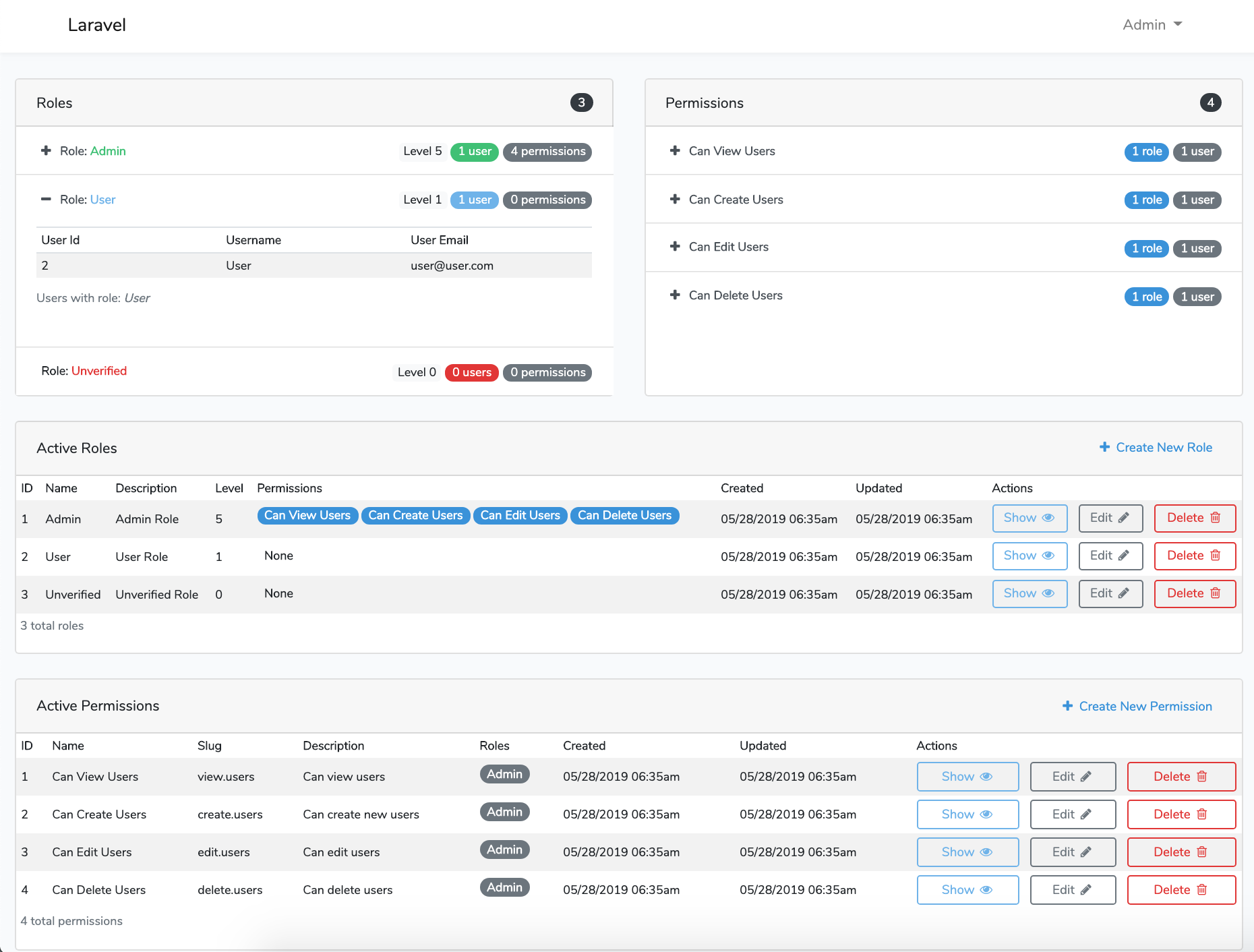
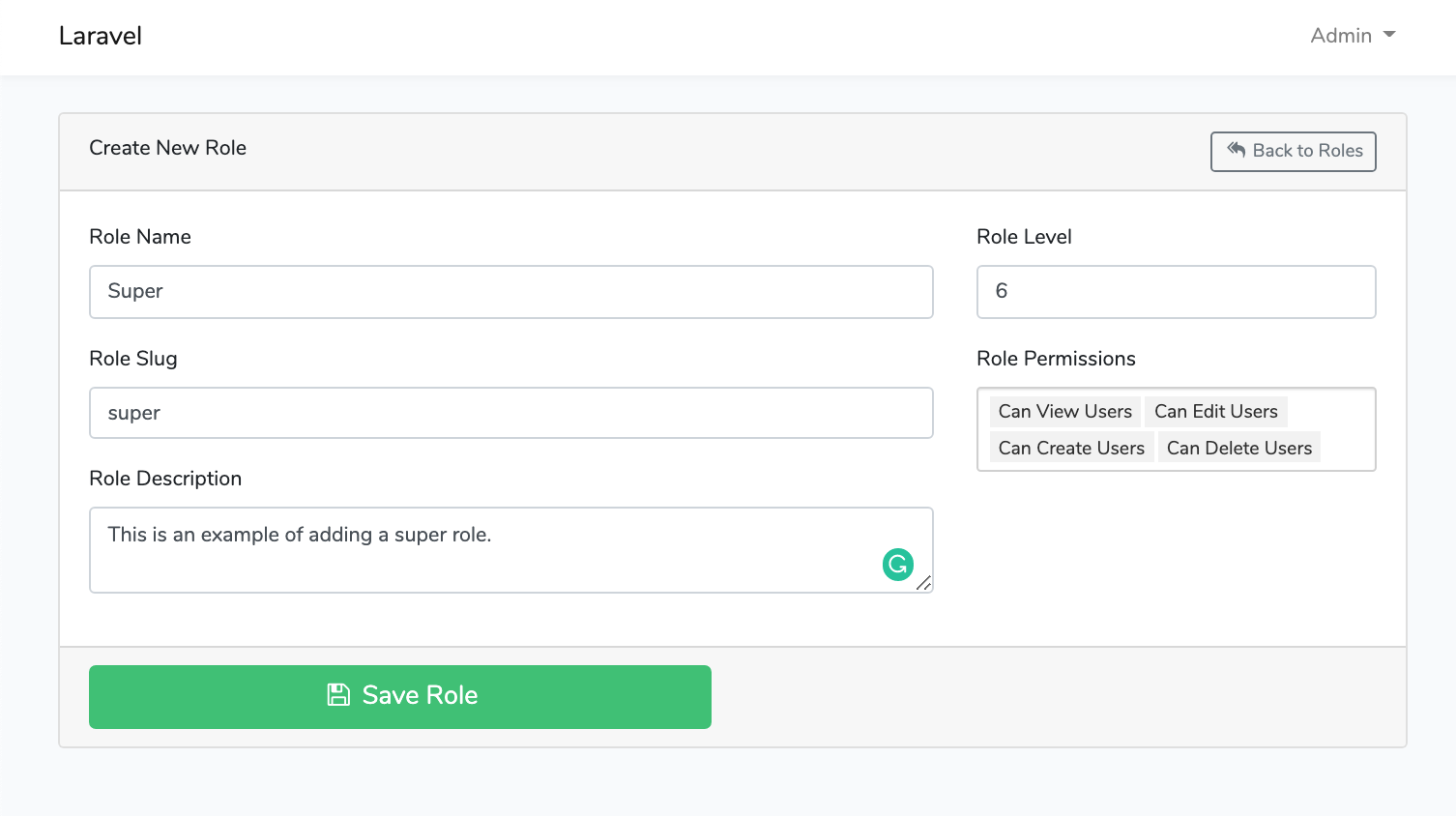
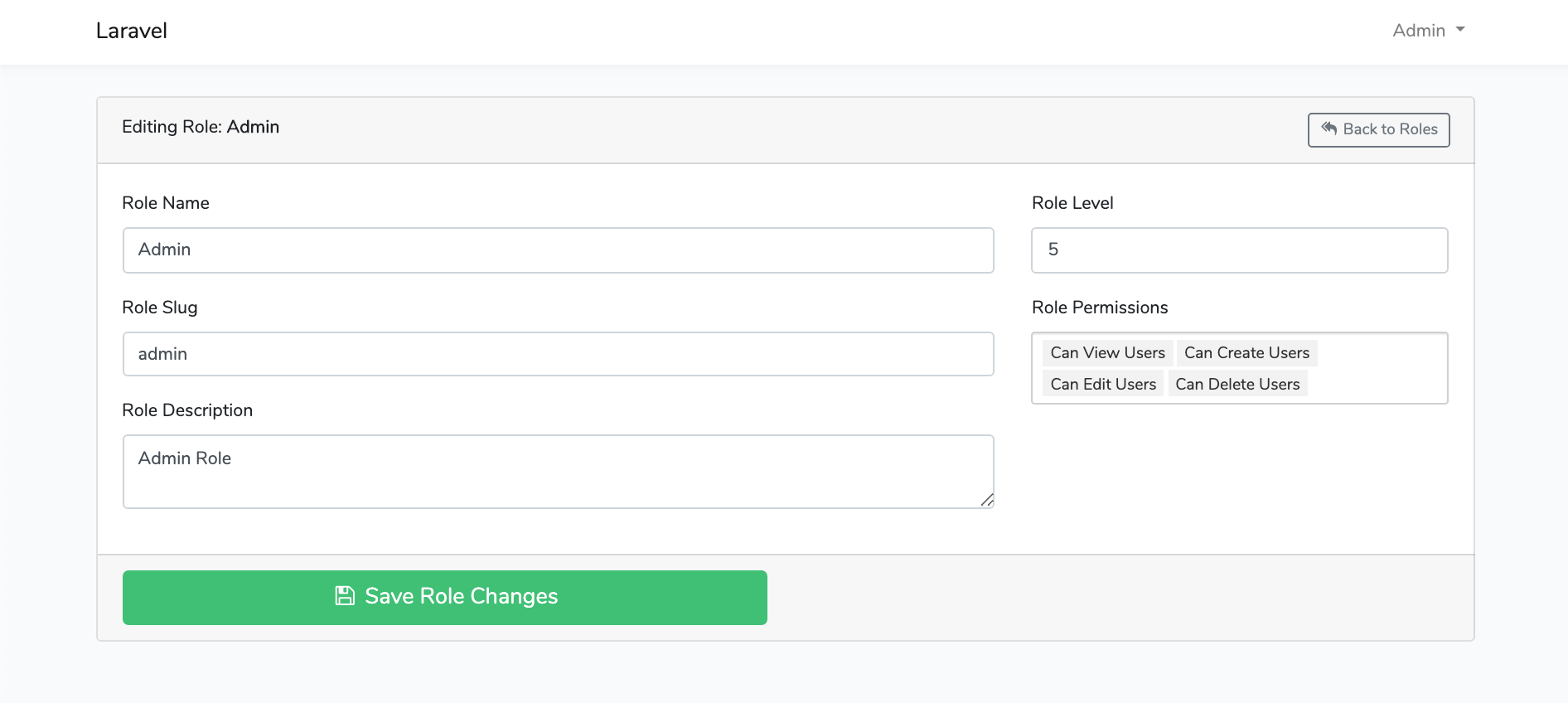
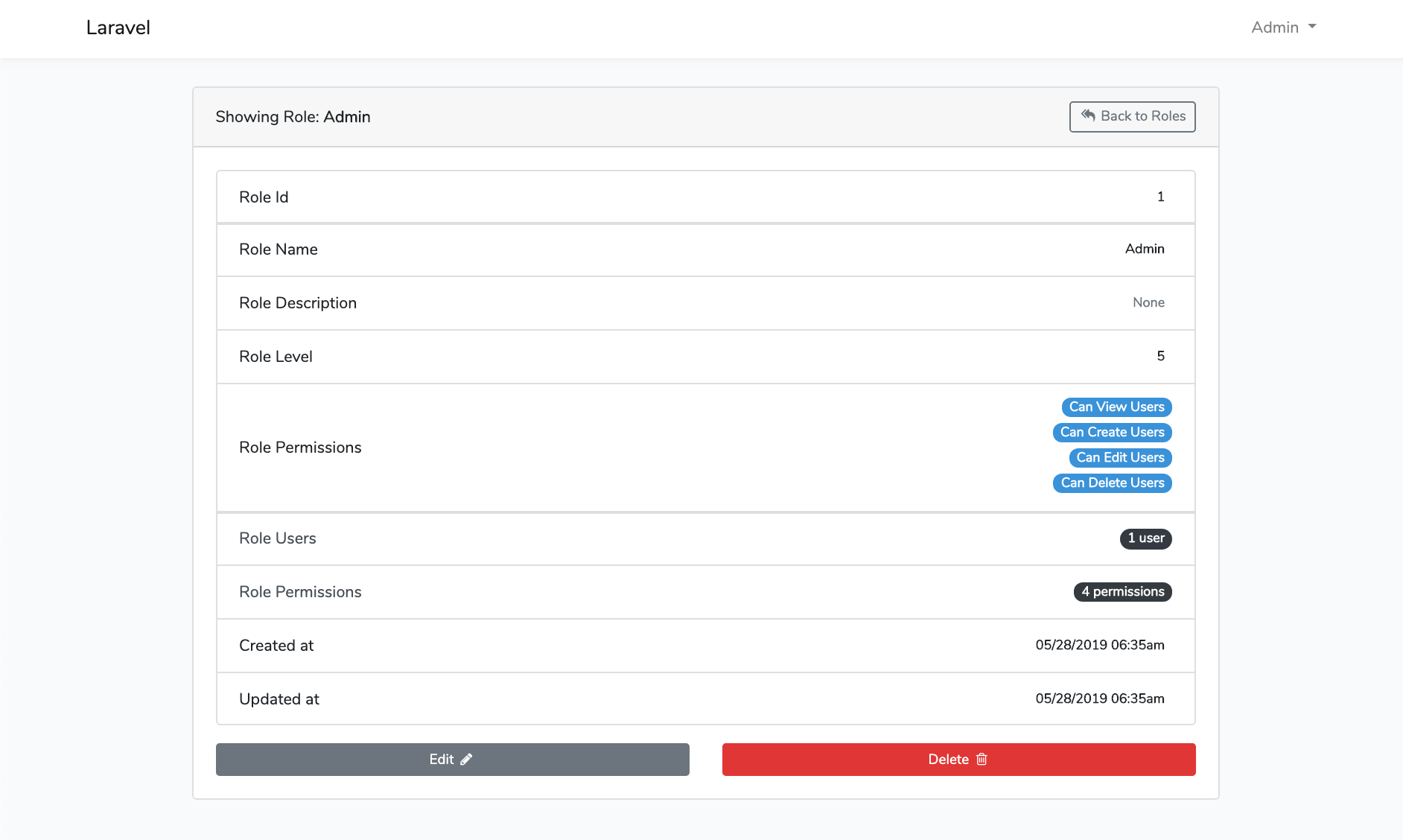

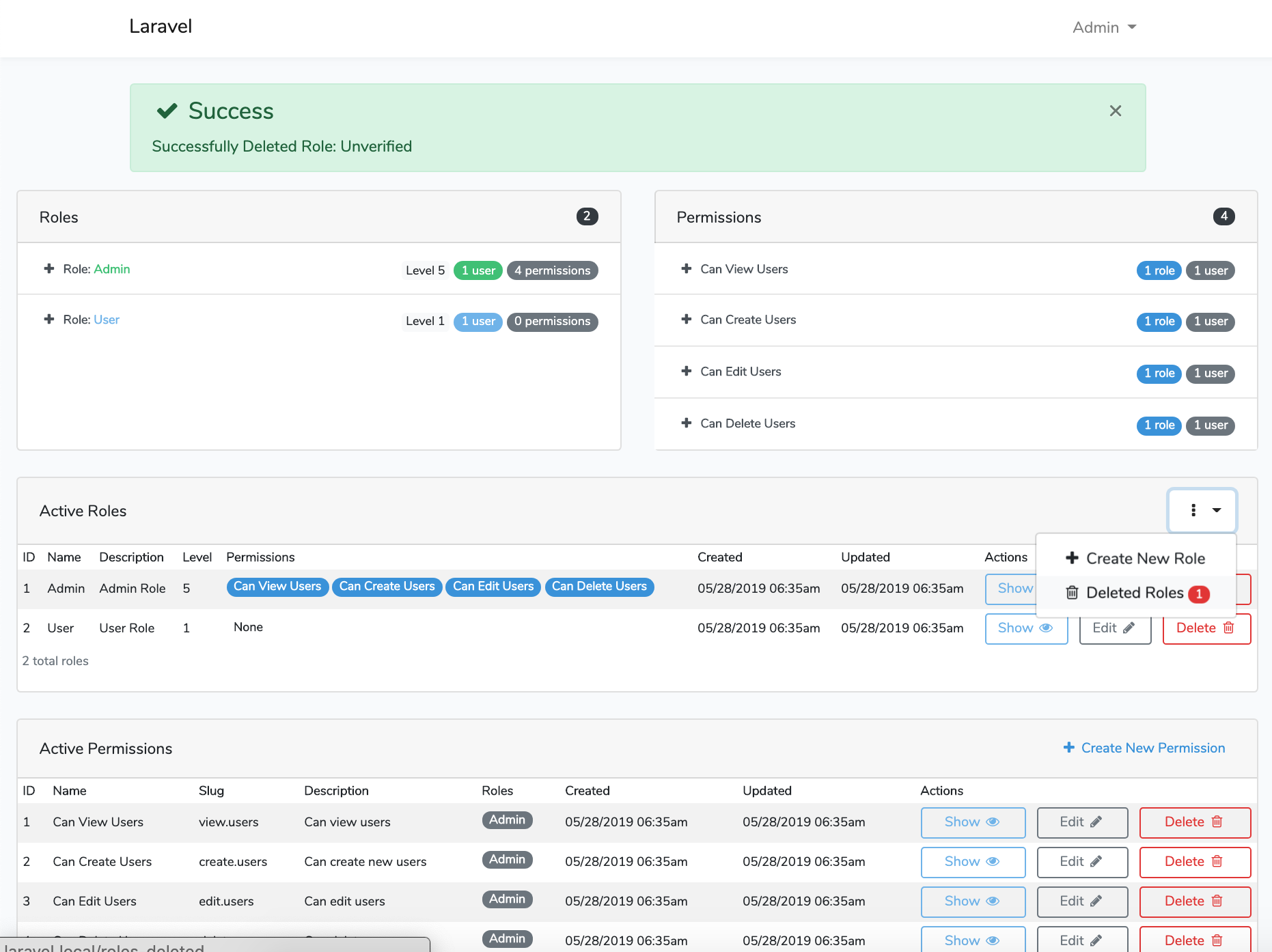
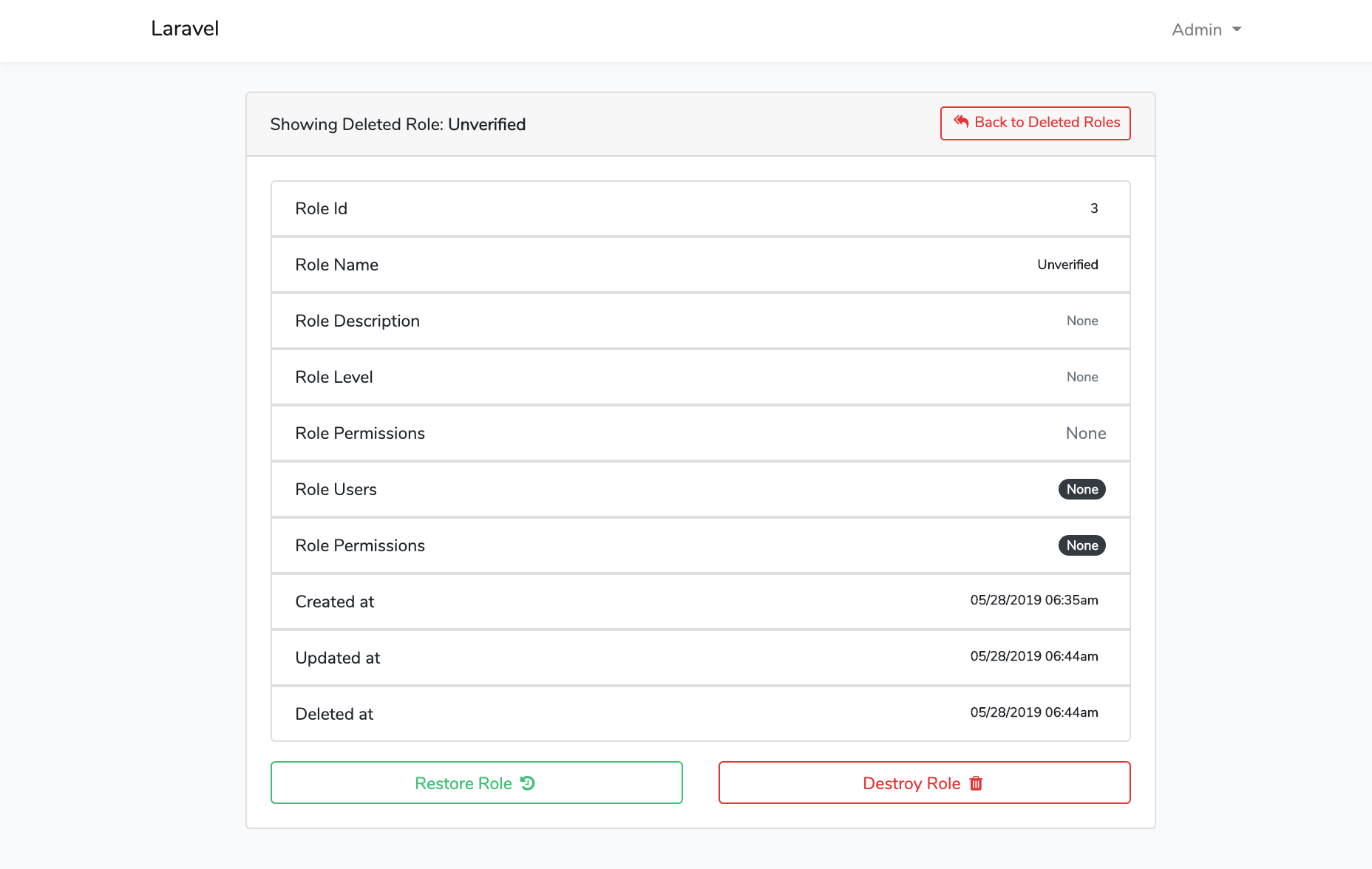
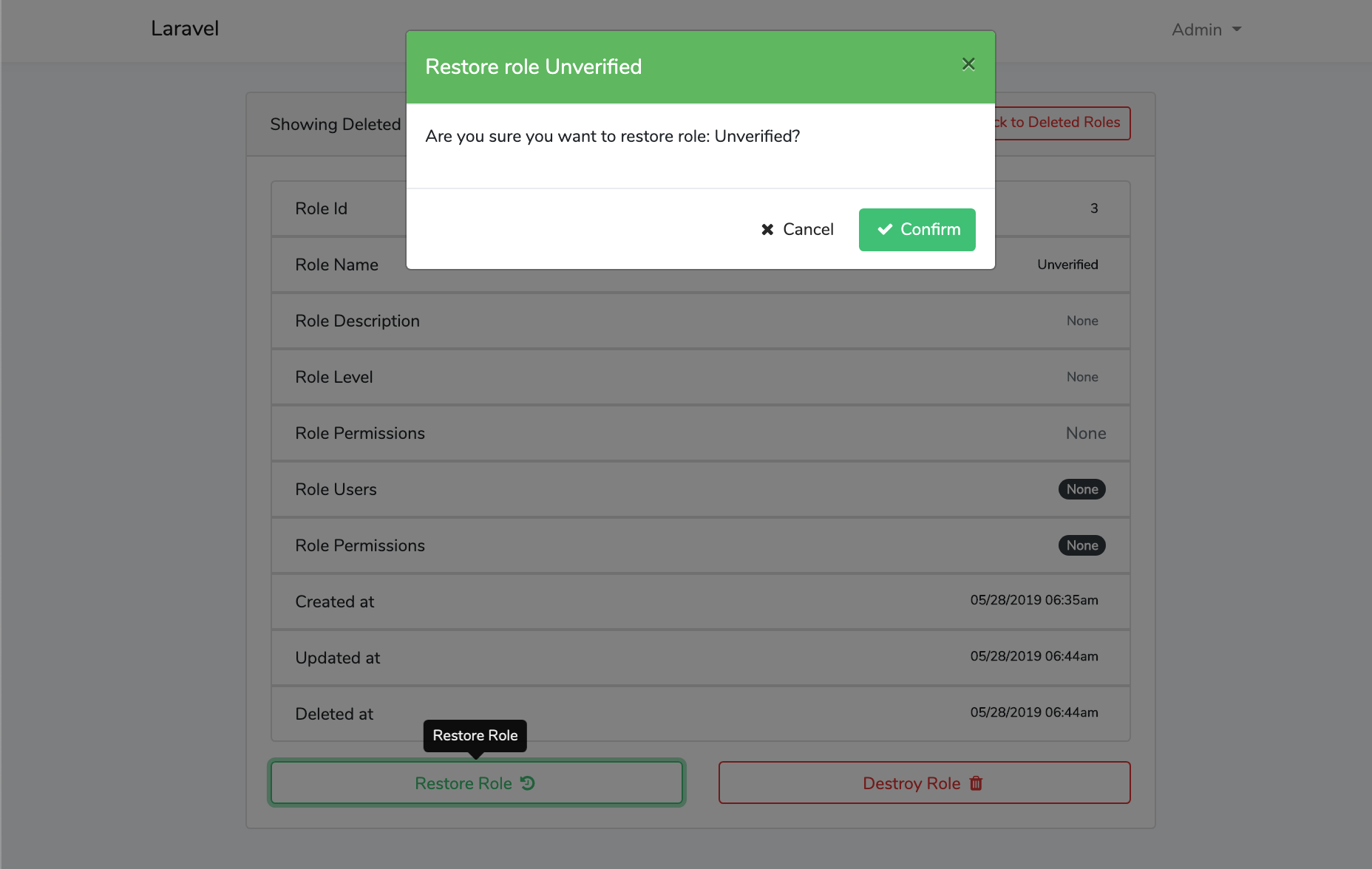
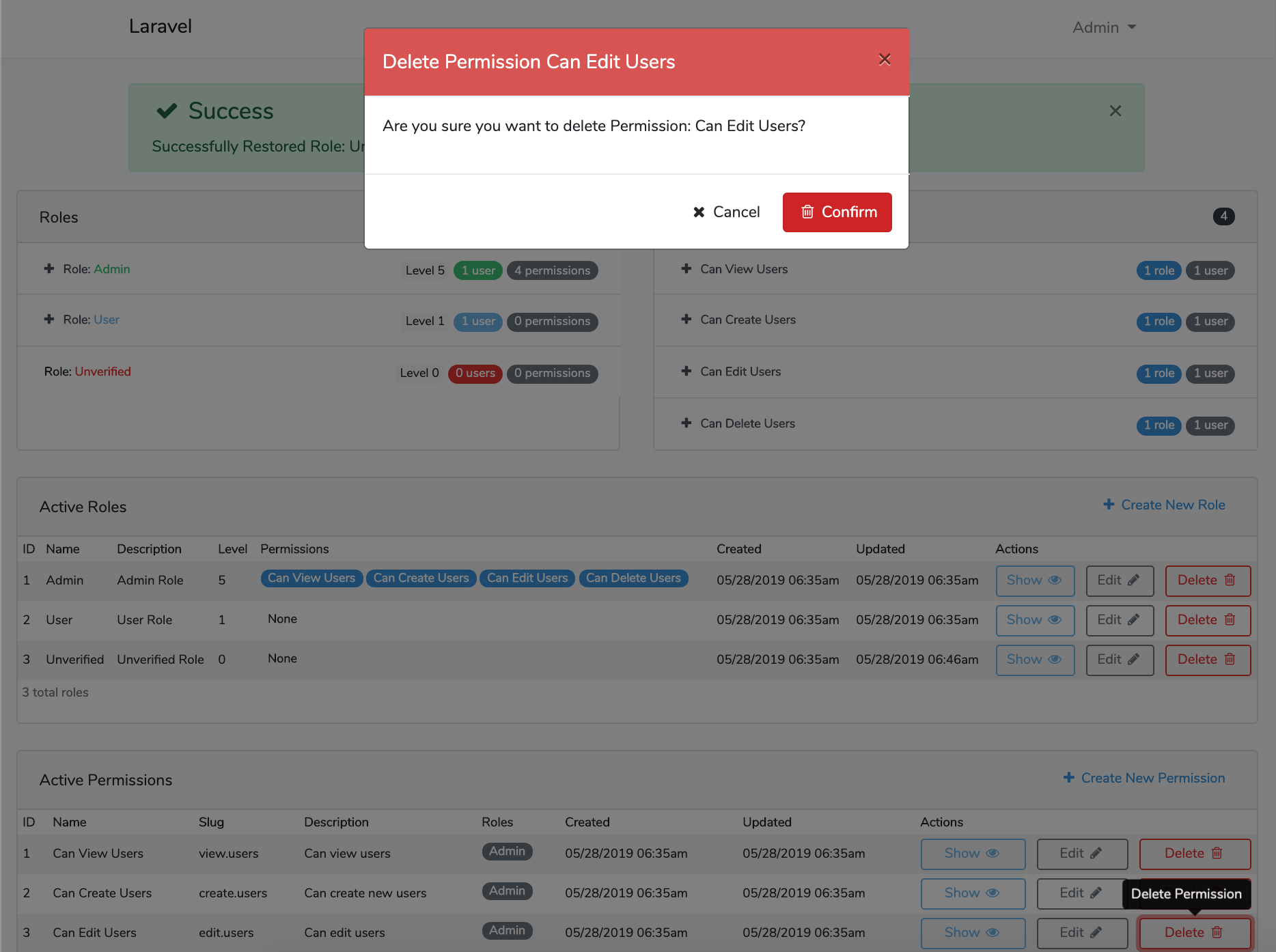
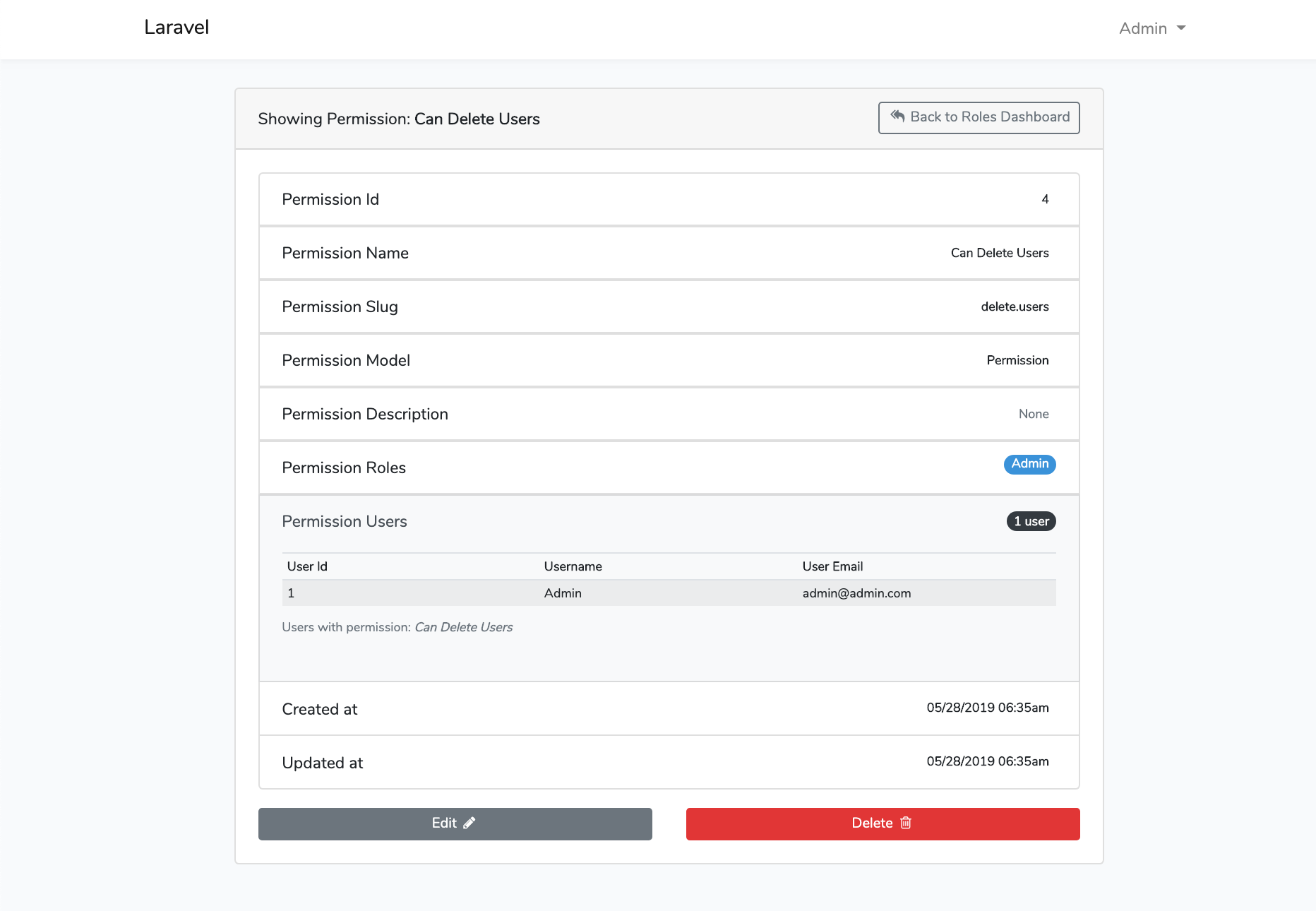
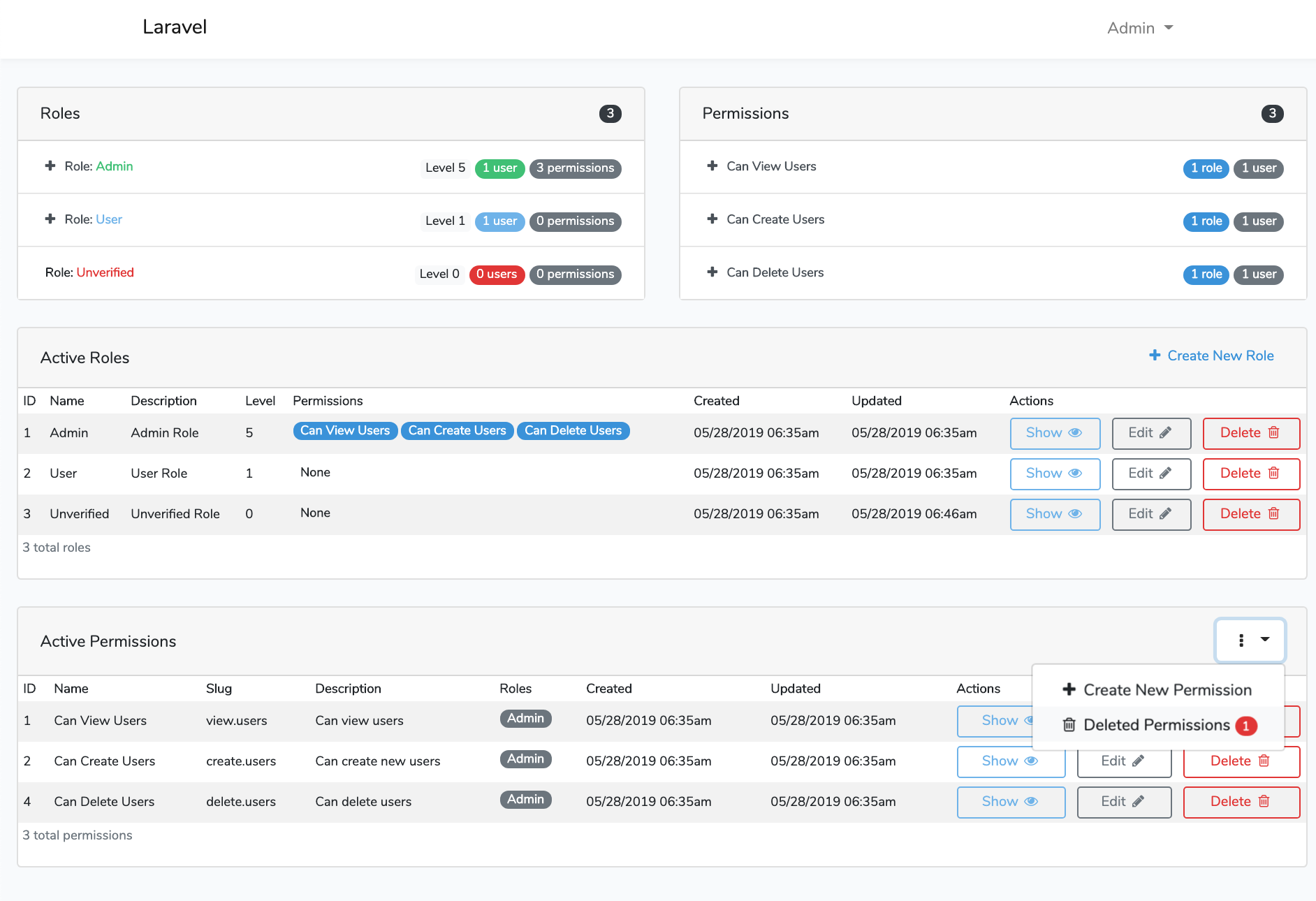
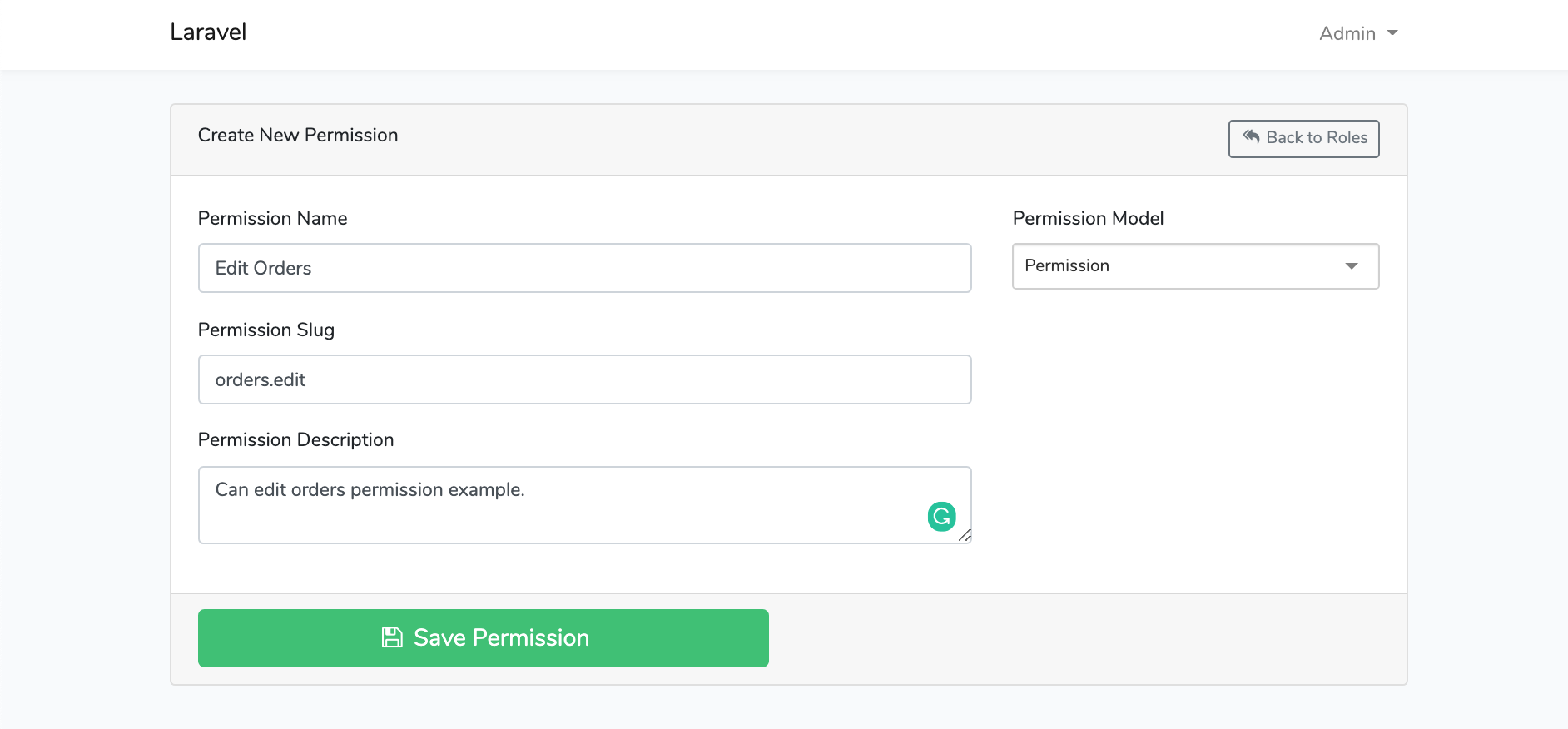


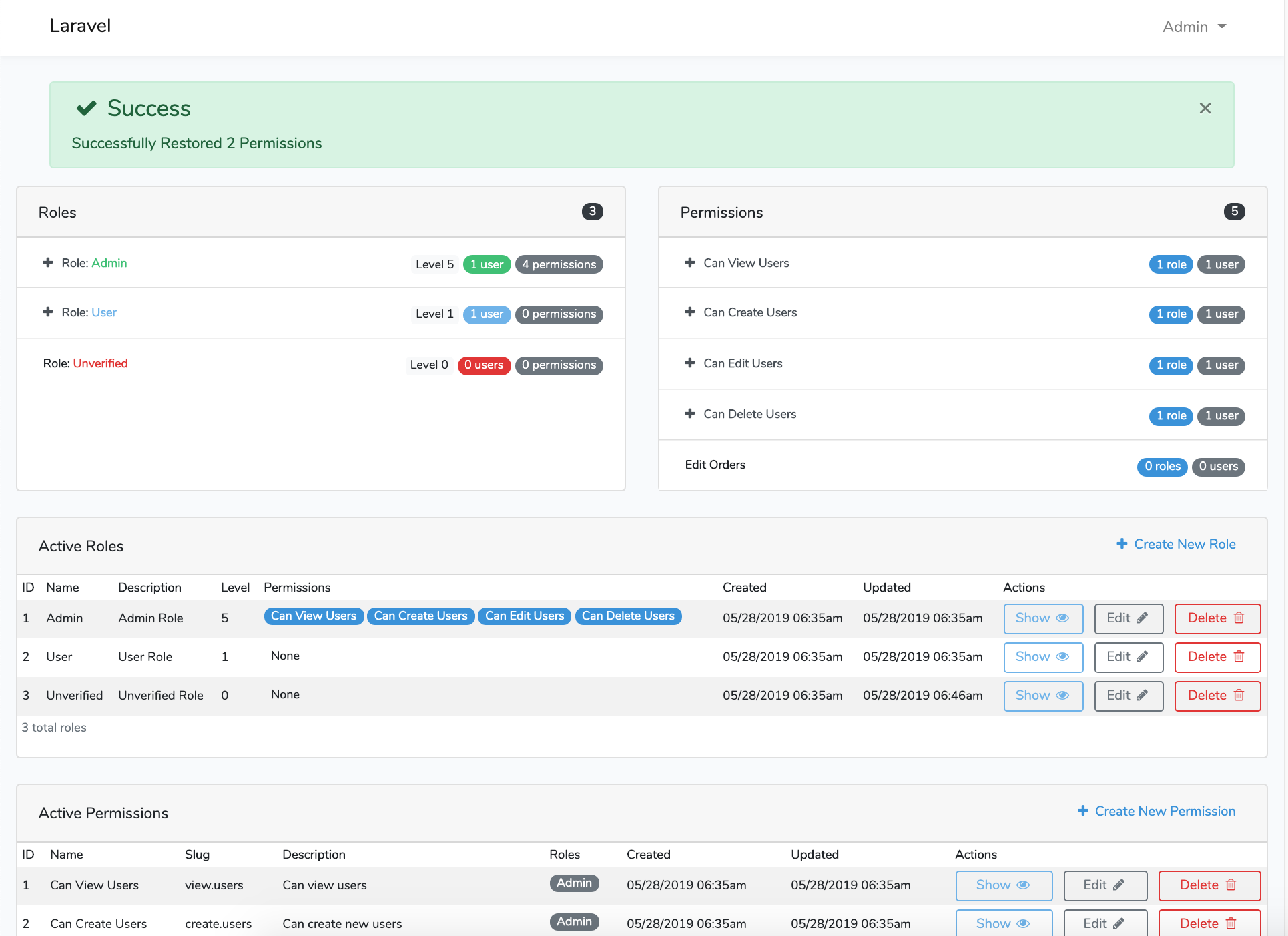 , (*42)
, (*42)
File Tree
├── .env.example
├── .env.travis
├── .gitignore
├── .travis.yml
├── LICENSE
├── composer.json
├── phpunit.xml
├── readme.md
└── src
├── App
│ ├── Exceptions
│ │ ├── AccessDeniedException.php
│ │ ├── LevelDeniedException.php
│ │ ├── PermissionDeniedException.php
│ │ └── RoleDeniedException.php
│ ├── Http
│ │ ├── Controllers
│ │ │ ├── Api
│ │ │ │ └── LaravelRolesApiController.php
│ │ │ ├── LaravelPermissionsController.php
│ │ │ ├── LaravelRolesController.php
│ │ │ ├── LaravelRolesDeletedController.php
│ │ │ └── LaravelpermissionsDeletedController.php
│ │ ├── Middleware
│ │ │ ├── VerifyLevel.php
│ │ │ ├── VerifyPermission.php
│ │ │ └── VerifyRole.php
│ │ └── Requests
│ │ ├── StorePermissionRequest.php
│ │ ├── StoreRoleRequest.php
│ │ ├── UpdatePermissionRequest.php
│ │ └── UpdateRoleRequest.php
│ └── Services
│ ├── PermissionFormFields.php
│ └── RoleFormFields.php
├── Contracts
│ ├── HasRoleAndPermission.php
│ ├── PermissionHasRelations.php
│ └── RoleHasRelations.php
├── Models
│ ├── Permission.php
│ └── Role.php
├── RolesFacade.php
├── RolesServiceProvider.php
├── Traits
│ ├── DatabaseTraits.php
│ ├── HasRoleAndPermission.php
│ ├── PermissionHasRelations.php
│ ├── RoleHasRelations.php
│ ├── RolesAndPermissionsHelpersTrait.php
│ ├── RolesUsageAuthTrait.php
│ └── Slugable.php
├── config
│ └── roles.php
├── database
│ ├── Migrations
│ │ ├── 2016_01_15_105324_create_roles_table.php
│ │ ├── 2016_01_15_114412_create_role_user_table.php
│ │ ├── 2016_01_26_115212_create_permissions_table.php
│ │ ├── 2016_01_26_115523_create_permission_role_table.php
│ │ └── 2016_02_09_132439_create_permission_user_table.php
│ └── Seeds
│ ├── DefaultConnectRelationshipsSeeder.php
│ ├── DefaultPermissionsTableSeeder.php
│ ├── DefaultRolesTableSeeder.php
│ ├── DefaultUsersTableSeeder.php
│ └── publish
│ ├── ConnectRelationshipsSeeder.php
│ ├── PermissionsTableSeeder.php
│ ├── RolesTableSeeder.php
│ └── UsersTableSeeder.php
├── resources
│ ├── lang
│ │ └── en
│ │ └── laravelroles.php
│ └── views
│ └── laravelroles
│ ├── cards
│ │ ├── permissions-card.blade.php
│ │ └── roles-card.blade.php
│ ├── crud
│ │ ├── dashboard.blade.php
│ │ ├── permissions
│ │ │ ├── create.blade.php
│ │ │ ├── deleted
│ │ │ │ └── index.blade.php
│ │ │ ├── edit.blade.php
│ │ │ └── show.blade.php
│ │ └── roles
│ │ ├── create.blade.php
│ │ ├── deleted
│ │ │ └── index.blade.php
│ │ ├── edit.blade.php
│ │ └── show.blade.php
│ ├── forms
│ │ ├── create-permission-form.blade.php
│ │ ├── create-role-form.blade.php
│ │ ├── delete-sm.blade.php
│ │ ├── destroy-all-permissions.blade.php
│ │ ├── destroy-all-roles.blade.php
│ │ ├── destroy-sm.blade.php
│ │ ├── edit-permission-form.blade.php
│ │ ├── edit-role-form.blade.php
│ │ ├── partials
│ │ │ ├── permission-desc-input.blade.php
│ │ │ ├── permission-name-input.blade.php
│ │ │ ├── permission-slug-input.blade.php
│ │ │ ├── permissions-model-select.blade.php
│ │ │ ├── role-desc-input.blade.php
│ │ │ ├── role-level-input.blade.php
│ │ │ ├── role-name-input.blade.php
│ │ │ ├── role-permissions-select.blade.php
│ │ │ └── role-slug-input.blade.php
│ │ ├── permission-form.blade.php
│ │ ├── restore-all-permissions.blade.php
│ │ ├── restore-all-roles.blade.php
│ │ ├── restore-item.blade.php
│ │ └── role-form.blade.php
│ ├── modals
│ │ └── confirm-modal.blade.php
│ ├── partials
│ │ ├── bs-visibility-css.blade.php
│ │ ├── flash-messages.blade.php
│ │ ├── form-status.blade.php
│ │ └── styles.blade.php
│ ├── scripts
│ │ ├── confirm-modal.blade.php
│ │ ├── datatables.blade.php
│ │ ├── form-inputs-helpers.blade.php
│ │ ├── selectize.blade.php
│ │ ├── selectizePermission.blade.php
│ │ └── tooltips.blade.php
│ └── tables
│ ├── permission-items-table.blade.php
│ ├── permissions-table.blade.php
│ ├── role-items-table.blade.php
│ └── roles-table.blade.php
└── routes
├── api.php
└── web.php
- Tree command can be installed using brew:
brew install tree
- File tree generated using command
tree -a -I '.git|node_modules|vendor|storage|tests'
Opening an Issue
Before opening an issue there are a couple of considerations:
* You are all awesome!
* Read the instructions and make sure all steps were followed correctly.
* Check that the issue is not specific to your development environment setup.
* Provide duplication steps.
* Attempt to look into the issue, and if you have a solution, make a pull request.
* Show that you have made an attempt to look into the issue.
* Check to see if the issue you are reporting is a duplicate of a previous reported issue.
* Following these instructions show me that you have tried.
* If you have a questions send me an email to jeremykenedy@gmail.com
* Need some help, I can do my best on Slack: https://opensourcehelpgroup.slack.com
* Please be considerate that this is an open source project that I provide to the community for FREE when opening an issue., (*43)
Credit Note:
The HasRoleAndPermission Trait And Contract is and an adaptation of romanbican/roles. I liked the method he made so I used them., (*44)
License
This package is free software distributed under the terms of the MIT license. Enjoy!, (*45)
 Wallogit.com
Wallogit.com
 , (*1)
, (*1)
















 , (*42)
, (*42)